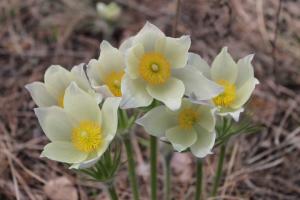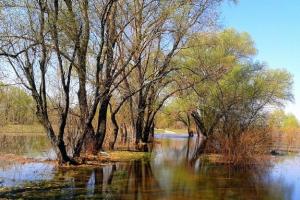Perennial, which is well suited for a variety of decorative plantings- delphinium. Growing hybrid forms is quite common in floriculture, although there are also beautiful wild species. Delphinium has powerful bushes about two meters high. The leaves are palpator-shaped, large. Flowers of various colors (white, purple, etc.) reach a diameter of 5 cm. The flowers are collected in an inflorescence - a raceme. This is what makes up the beauty of the delphinium. The brushes are long, thick, lush. Their length can reach 60-120 cm. Flowers bloom from bottom to top. If you remove faded shoots in a timely manner, then in some forms favorable conditions New inflorescences develop and the decorative effect remains until the beginning of September. After flowering, the decorative effect is lost.
Growing delphinium from seeds
To prevent delphinium seeds from losing their viability, it is recommended to keep them in the refrigerator at a temperature of plus five degrees in a sealed glass container. Since seedlings are susceptible to various diseases, before sowing the substrate must be disinfected with a 3-5% formaldehyde solution, and the seeds must be treated with a fungicide or 0.1 percent (place in gauze bags in the solution for ten minutes). Sowing of seeds is done in different conditions. They are sown in a furrow before winter, when stable frosts set in. The soil is prepared in advance. The seeds are covered with humus on top, which is stored in a dark room until sowing. Sometimes seeds are sown directly into the ground in the spring (April, May). Dense seedlings are thinned out (10 to 10) when the seedlings have several true leaves. Excess plants are transferred to the ridges, protecting them from the sun with shields at first. But guaranteed production of seedlings can be achieved when working in a greenhouse, room, or greenhouse. The best time for sowing seeds is March. In this case, the delphinium blooms in August.
Substrates:
Humus: sand: turf soil (2/1/1);
Leaf (peat soil): river sand: (2/1/1).
How to grow delphinium from seeds
It turned out that amateurs often have unsuccessful sowings. Indeed, sowing and growing delphinium from seeds requires compliance with mandatory details. Below is a detailed technique that will ensure high-quality cultivation of delphinium from seeds and production of seedlings, developed by delphinium culture specialist N.I. Malyutin. The prepared substrate must be sifted. The soil in the boxes, especially at the side walls, is well compacted and watered abundantly. Dry soil is added on top, after which the surface must be carefully leveled with a ruler. Otherwise, water will flow into the depressions, which can lead to uneven seedlings and even rotting. Sow randomly at the rate of 1-2 seeds per 1 cm². When planting, seeds should be lightly pressed into the ground with a tamper. Then carefully water it and cover it with a layer of about 3 mm of soil, sifting it through a fine sieve. Failures during sowing are associated with deep seeding. If the seeds are slightly exposed after watering, they can be lightly sprinkled with soil. To protect the substrate from drying out, the boxes are covered with paper. After germination (about 10 days at a temperature of 15 - 16°C), the paper is removed and the boxes are placed closer to the light. It is necessary to ensure uniform moisture of the soil. Lack of moisture manifests itself in the form of dark green coloring of leaves and cotyledons, which are usually light. If, when watering, the water does not penetrate to the bottom of the boxes, they should be placed briefly in iron pans filled with water. Then the moisture will flow to the roots, leaving the surface of the earth dry, and the seedlings will not suffer from the “black leg”. If delphinium is grown from seeds using the above method, the first leaves appear within 4-6 weeks. Seedlings dive into the nursery at a distance of about 4 cm. It is important to consider that delphinium seeds with dark-colored flowers take longer to germinate than those with light flowers. Therefore, there is no need to postpone picking when sowing varieties with light flowers. When picking seedlings, you must be careful not to cover the growing point with soil. Deep planting is undesirable. After transplantation, the seedlings need to be watered warm water and place in a shaded place for 5-6 days, and then give full light. Plants are ready for planting in the main soil by May.
Delphinium is a flower crop that requires a little more attention compared to other perennials. At the same time, growing perennial delphinium from seeds is not difficult if you adhere to basic agricultural practices. Knowing the rules of planting and care, you can grow perennial delphinium from seeds even in the Moscow region. Its luxurious flower stalks, as tall as a man, will become a stunning decoration of the garden and will delight and delight you and your guests.
Planting perennial delphinium
Perennial delphinium is grown through seedlings. When choosing varieties, you need to pay attention to quality planting material and do not purchase delphinium annual seeds by mistake. Seeds are sown in the spring, having previously prepared them. The seedlings are illuminated, grown and planted in the ground at permanent place. When growing seedlings, protect them from blackleg and water them carefully.
Delphinium planting dates
In the Moscow region, perennial delphinium is sown for seedlings in mid-March. With such sowing dates, the seedlings are transplanted to a permanent place after two months. If you plant seedlings in the ground at a later time, they will not have time to take root well, and therefore will not survive the winter.
Scarification of delphinium seeds before planting
Delphinium seeds are covered with a hard shell and require scarification - mechanical disruption of the shell. Therefore, in order to facilitate germination and increase the germination of seeds, I advise you to “walk” through them before sowing sandpaper small fraction.
Planting delphinium seeds for seedlings
When choosing delphinium seeds, you need to be especially careful and not fall for the tricks of sellers - it happens that some pass off annual delphinium as perennial. A year after sowing such a delphinium, not a trace remains of the plants. As a rule, annual delphiniums are characterized by simple-shaped flowers; they are two-colored, red or orange, blue or white.
Soil for delphinium seedlings
To get healthy delphinium seedlings, you need to take care to protect future seedlings from diseases such as “blackleg”. To do this, you need to carefully prepare a special soil mixture. It is better to take them as a basis, soak them and shake out the contents into a flat container. Add to this 1 part of river sand and a pinch of sifted ash, mix thoroughly. Spill the containers themselves with a solution of phytosporin or potassium permanganate.
Delphinium sowing scheme
Caring for delphinium seedlings
After 1.5-2 weeks, when the sprouts appear, place the containers with them under a fluorescent lamp (LED), turn on the light for 10-12 hours a day. Water the seedlings carefully, along the edge of the container, trying not to get on the plants themselves. Since the bulk of the soil mixture is peat, the soil dries out quite quickly. During the first weeks, water containers with seedlings once every 2 days, and after a month, twice a day.
In mid-May, seedlings can be planted in the ground.
For more information on how to grow delphinium seedlings, read the article:

How to plant perennial delphinium correctly
The main problem when growing delphinium is dampness, which is typical for the main territory of the Moscow region. In the garden, I prefer to plant delphinium in one place, this makes it easier to prepare the desired soil composition and care for the plants.
Soil for planting delphinium
It must be remembered that delphinium cannot tolerate the presence of peat in the soil. This leads to the death of the bush in the second year. Therefore, for future plantings of delphinium, I am preparing a special mixture; I am trying to completely change the native peat bogs, because they are not suitable for delphinium.
When planting, I take out the soil on the bayonet of a shovel, put drainage in the form of crushed stone, sand or expanded clay with a layer of 20 cm - this will protect the plantings in the spring from groundwater. I prepare this soil mixture per 1 square meter. m: a bucket of rotted compost, two glasses of ash, a glass of bone meal, 2 tablespoons of superphosphate and ordinary soil. I try to ensure that the finished flower bed is 20 cm higher than the soil level in the garden.
Scheme for planting delphinium in the ground
I water the planting area with a solution of phytosporin and plant delphinium seedlings at a distance of 30 cm from each other. It is important that the root collar is at soil level; it should not be buried. I stick low arches over the plantings and cover them with thin non-woven material from the sun, I leave the ends on the north side open.

Caring for perennial delphinium
The key to longevity for delphinium is timely pruning. As soon as the petals begin to fall off the flower stalks, I immediately cut them off at the base and cover the “stumps” with caps. The fact is that the delphinium has hollow stems, when cut, moisture gets inside, and the bush begins to rot. I cover such stems with caps from lipstick and other cosmetics. Plants with caps overwinter.
I also cover the plantings with a double layer of non-woven fabric on top of the ground for the winter. I noticed that such a simple shelter ensures 100% survival of plants during winters with little snow.
Caring for delphinium during flowering
When caring for delphinium, you need to carefully monitor the flowering periods. The perennial delphinium blooms in the second year after sowing, throwing out gorgeous flower stalks.
- In the first year, I don’t allow the perennial delphinium to bloom; I pluck out the buds at the base. This technique helps to build up a powerful root system, while flowering weakens the plant, and before winter it goes away weakened, as a result of which it may not survive it.
- When extending peduncles, it is important to immediately tie the delphinium stems in several places to strong supports.
- In the conditions of the Moscow region, delphinium produces two waves of flowering, but I do not allow secondary formation of flower stalks in early September, so as not to weaken the bush.
Feeding perennial delphinium
Before starting any feeding, I first water the delphinium with plain water so as not to burn the roots.
- At the beginning of the second year, in mid-May, I fertilize with green fertilizer (infusion of grass).
- At the end of June, I add ash extract to the herbal infusion, one part per 10 liters of water.
- In the middle or end of August, I water the plantings with an infusion of ash.

Diseases of delphinium perennial
In the conditions of the Moscow region, due to dampness, delphinium is susceptible to fungal diseases. Powdery mildew - a constant companion of delphinium plantings. The disease attacks plants in mid-July and affects flower stalks. By this point, the delphinium has already faded, so there are no problems powdery mildew does not deliver. I burn cut flower stalks with signs of disease; newly growing shoots are not susceptible to the disease, so I do not treat powdery mildew.
Loves to eat young shoots aphid . I try to collect it manually; if there is a large accumulation, I treat it with Actellik or Karbofos.
Reproduction of delphinium perennial
Perennial delphinium needs timely division, I carry out this work every two years, in mid-August.
Propagating delphinium by seeds is an excellent way to obtain the required amount of planting material or become the owner of the desired variety. It must be remembered that often delphinium grown from seeds rarely repeats the varietal characteristics and corresponds to the description. When sowing your own seeds, as a rule, a delphinium grows with blue or pale lilac flower stalks.
Delphinium or spurn is a wonderful addition to your garden. Gardeners simply adore it. Candle-like inflorescences rise above other species and give the garden nobility and sophistication.
Delphinium flowers tolerate both drought and frost well. Terry buds interesting shapes and shades will never add boredom to your garden.
Delphinium amazes with its variety of varieties and species, about 400 beautiful representatives. The color range of this plant is incredibly diverse, but it is most valued in landscape design blue shades, which the spur is certainly rich in. Delphinium blooms 2 times a year, which makes it possible to double enjoy its beauty.
What does delphinium like, choice of location and soil
 Delphinium is a plant that does not require too much effort to plant and care for. For successful growth and care of the delphinium, you need to select right place. This plant loves the sun, but is afraid of windy spaces. Therefore, we choose a suitable place for him.
Delphinium is a plant that does not require too much effort to plant and care for. For successful growth and care of the delphinium, you need to select right place. This plant loves the sun, but is afraid of windy spaces. Therefore, we choose a suitable place for him.
Important! When planting a delphinium, make sure that it is in the sun until lunchtime, and then covered in partial shade.
As soon as you plant the delphinium, make sure that the soil is fertilized with compost or rotted manure, which will ensure abundant and rich flowering.
Delphinium tolerates the cold season well. It can withstand low temperatures, down to - 40°C. When planting delphinium, you first need to choose the right place. Dig up the soil and sprinkle with fertilizers, compost or humus. But all this must be done in moderation, since, although he is unpretentious, he does not respect acidic soil.
Did you know? The acidity of the soil affects the color saturation of the delphinium.
How to plant delphinium
 Delphinium is grown in different ways. Some people plant seeds right away (fraught with late flowering and death of the seeds), while others first grow young sprouts in trays and then plant the future beauty in specially prepared soil.
Delphinium is grown in different ways. Some people plant seeds right away (fraught with late flowering and death of the seeds), while others first grow young sprouts in trays and then plant the future beauty in specially prepared soil.
The holes for planting spurs should be 4-5 cm deep. The distance between flowers must be determined independently, it all depends on the size of the future plant (20-30 cm). The soil that you removed from the holes prepared for young plants can be mixed with peat or rotted humus 1:2, filled with it at the bottom of the holes, and then the plants can be planted.
Important! When transplanting young plants, there is no need to cover the root collar with soil deeper than the soil level.
How to water and feed an extraordinary flower
Caring for delphinium is simple and pleasant. I am pleased with his unpretentiousness in almost all aspects of care.
Such a plant needs watering, weeding, fertilizers, pruning, and installation of supports. The flower survives the winter well, so it does not need sheltering or replanting in tubs. Delphinium begins to bloom in June.
During periods of drought, the spur needs watering, but we should not forget that it does not like stagnant water, so do not overwater it. You need to water at the root, otherwise if water gets on the leaves, the plant will get burned.
 At proper care delphinium blooms for up to 50 days. Every time you need to cut off the stems that have faded. With regular watering and pruning, you can also admire the blooming delphinium in the fall.
At proper care delphinium blooms for up to 50 days. Every time you need to cut off the stems that have faded. With regular watering and pruning, you can also admire the blooming delphinium in the fall.
The plant is also periodically susceptible to various diseases and pests - rotten root collar, powdery mildew, wilting, viral diseases, spider mite, delphinium fly, etc.
The optimal period for delphinium growth is 3 years. You should not leave it longer, as the central core of the bush rots and the plant loses its floweriness.
Important!After the flowering season, you need to cut off the dead flowers, and then the delphinium will delight you with its beautiful appearance next season.
Rules for trimming and gartering delphinium
Delphinium pruning is divided into 2 stages:
- In the first stage, when the shoots reach 20-25 cm, you need to break off the weaker and thinner shoots, and leave the strongest ones (up to 5 pieces). This is done so that the plant does not spray its resources on all the shoots, because there will be no beautiful flowers on either large or small ones. This is all that in this case requires caring for the delphinium in the spring and early summer.
- The second stage is the post-flowering stage. It depends on whether you want to keep the seeds or not. You can simply cut the flower and place it in a vase, or you can leave the shoot until the fall so that the fruit is ripe for planting next year.
Important!After flowering, the decorative beauty of flowers and aesthetics are lost. This affects the look of your garden.
 Delphinium also needs a garter. After you have thinned out the shoots and left the strongest ones, after 1.5-2 weeks, when the growth of the shoots is close to 0.5 meters, you need to start staking them.
Delphinium also needs a garter. After you have thinned out the shoots and left the strongest ones, after 1.5-2 weeks, when the growth of the shoots is close to 0.5 meters, you need to start staking them.
Prepare long stakes in advance and install them around the spur bush. Then tie a plant shoot to each peg. Garters should be made of fabric, as twine can damage thin stems.
In autumn, when the leaves of the plant have already died, the shoots should not be pruned. They are tubular - and water can get in there, leaving you with a rotten plant in the spring.
Important!When installing stakes, be careful that they do not damage the rhizome of the plant.
How to propagate delphinium
The species of delphiniums is very large and diverse. There are perennial, annual and crossed species. The most optimal and widespread is considered to be the crossed or cultivated spur. Delphinium is propagated in the traditional and, as you know, most accessible way - by planting delphinium from seeds, as well as by dividing the root itself. Delphinium should be cut half-bloomed, then it will stay in your vase for up to 12 days.
Rhizome division
At any age, the spur does not like this type of reproduction. Even if you separate young seedlings and not mature plant, some of them will most likely die. When dividing the root, you need to approach the work with maximum delicacy. When dividing the rhizome, do not use a shovel and simply divide the root in half. The plant will definitely die.
 To divide the root you need in early spring or in the fall, dig it up and carefully, without damaging the buds, separate it with your hands or cut it with a sharp knife. And those places where the plant was damaged must be treated with ash.
To divide the root you need in early spring or in the fall, dig it up and carefully, without damaging the buds, separate it with your hands or cut it with a sharp knife. And those places where the plant was damaged must be treated with ash.
Interesting fact! Light varieties (pink and white) are most sensitive to such propagation.
Planting seeds
Delphinium is very interesting plant, its cultivation can begin not only by dividing the rhizome, but also from seeds. Propagation by seeds is the most affordable way. If you want to plant delphinium seeds, this must be done in March. The most optimal temperature, at which you can plant and germinate delphinium - +12- +15. Seeds should be sown in boxes and pots rarely, at a comfortable distance, as they do not like cramped conditions. There are no special care requirements for such seedlings; as usual, you just need frequent watering.
Plants should be replanted in June, but you can speed up this process a little and transplant them into “nursery nurseries” in May, where you can keep them until the next season, and in the spring, strong, healthy individuals can be transplanted to convenient permanent places.
 In the first year, when propagated by seed, the plants bloom weakly. At this time, they grow rhizomes and greenery. In the second year, the delphinium will delight you with its color 2 times - in July and August (it all depends on the variety). If you decide not to bother with seedlings and plant the seeds directly into the soil, then you should be prepared for this. First of all, you need to prepare the place where you will plant the seeds. Fertilizer should be applied to this area, possibly with wood ash, and dug 30 cm deep.
In the first year, when propagated by seed, the plants bloom weakly. At this time, they grow rhizomes and greenery. In the second year, the delphinium will delight you with its color 2 times - in July and August (it all depends on the variety). If you decide not to bother with seedlings and plant the seeds directly into the soil, then you should be prepared for this. First of all, you need to prepare the place where you will plant the seeds. Fertilizer should be applied to this area, possibly with wood ash, and dug 30 cm deep.
This sowing is done in so-called seed beds or furrows. They need to be watered generously before planting. Spur seeds should be planted rarely in these grooves, and carefully tamped down with your hands. To speed up the germination process, these ridges need to be covered with non-woven material or film. Then after 20-25 days, with moisture every 2-3 days, the first sprouts of delphinium will appear. After this, you can remove the cover.
Delphinium is a representative of the Buttercup family. Poisonous flower It can be one-, two-, or multi-year. It tolerates low temperatures well and grows up to 2 m in height. Blue, pink and soft white delphiniums decorate gardens and are used for vertical decoration of walls and fences. Ready seedlings exotic flowers will cost a decent amount. It is more profitable to purchase seeds and grow delphinium yourself.
Where to buy seed
Only employees of reputable nurseries and breeders know how to properly store seed. Exotic flower seeds lose viability when room temperature. The workpiece is kept in the refrigerator or special cameras, where it is always dry and the thermometer does not show more than zero.
Delphinium sold in markets or supermarkets does not sprout in 60–80%. The problem is not with the gardener who used the wrong substrate or fertilizer, but with the seed itself. Market traders don't know how to create the right conditions for exotic flowers. Pack the seeds in paper bags and store warm along with the rest of the plants. The result is a lack of seedlings and wasted money.
You can ask for delphinium seeds from your neighbors who grow colorful bushes. Several brown boxes are cut from healthy and well-developed plants. Deep color indicates that the flowers are ripe. Some people pick specimens that are just becoming covered with brown spots and store them in a cool room until the pieces change color.
The seeds are carefully poured onto Blank sheet, dried and placed in glass jars. The containers are placed in the refrigerator or freezer, taken out onto the balcony or veranda. At sub-zero temperature seed material is stored for up to 15 years. To “wake up” the delphinium, it is enough to stratify and plant the seeds in the ground.
Preparing the plant
The seed material is first disinfected:
- Prepare a deep pink solution of potassium permanganate or fungicide. They recommend Fitosporin or Maxim, which is diluted with water according to the instructions.
- Place delphinium seeds in a fabric bag and immerse in disinfectant liquid for 20 minutes.
- Remove the workpiece and wash off the remaining solution running water, and then put on a saucer and soak.
There should be little liquid; add a few drops of Epin or Zircon to it. The products stimulate growth and increase the percentage of seedlings. What to do after soaking?
- After a day, drain the fertilizer and place the seeds in a thin layer on damp gauze or a piece of cotton fabric.
- Roll the rag into a not too tight roll and place it in a plastic container.
- Place the container with the seed in the refrigerator and regularly add 10–20 ml of water so that it covers only the lower part of the gauze roll.
- When there is too much liquid, the seeds do not breathe and begin to rot.
- An alternative to water is wet moss, which is used to lay fabric rolls with delphinium.
Keep the seed in the refrigerator for about a week. When small white dots hatch, the workpiece is moved to the windowsill and kept under phytolamps or fluorescent lamps for several days. Germinated and heated seeds are planted in open ground or boxes with a special substrate.
Some gardeners soak the seed in early spring, wrap it in gauze and place it in plastic bags. The workpiece is buried in the ground and left for 1–2 weeks. They do this in April, when the snow begins to melt and the temperature ranges from – 5–10 to +3–6 degrees.
Growing in open ground

- peat and humus – 2 kg each;
- wood ash – 100–150 g;
- nitrophoska – 20–30 ml.
Coarse sand must be added to heavy soil. On square meter about a bucket and a half, so that the soil becomes more loose and moisture-permeable. Add 20–30 g of lime to soil with high acidity, otherwise the delphinium will be weak and dull.
The components are thoroughly mixed, poured onto the beds and the soil is dug to a depth of 25–30 cm. The area intended for growing exotic flowers is carefully leveled, breaking up lumps and removing remaining weeds. The area is lightly compacted and covered with shallow grooves.
The beds are filled with filtered water and sown with sprouted seeds. Cover future bushes with a centimeter layer of sifted soil. Protect from frost and rain with thick film or tarpaulin. The soil is regularly ventilated and moistened, and completely uncovered 20–25 days after emergence.
How to care for delphinium seedlings
- Make sure that the soil does not dry out.
- Apply fertilizers periodically: first nitrogenous, after flowering feed with phosphorus, and at the end of August and beginning of September feed with potassium.
- Loosen the soil and clear weeds.
This is enough for the plant to develop normally, form buds in a timely manner and throw out buds.
From refrigerator to drawer
Growing perennial delphiniums It's a troublesome job, but interesting. The seeds are disinfected and stratified, and then planted not in open ground, but in wooden or plastic boxes 10–20 cm deep.
While the seed swells and germinates, the substrate is prepared. Mix:
- leaf or turf soil;
- sand;
- humus.
Take the components by eye to get light, loose soil that allows air to pass through and does not retain excess moisture. It is advisable not to add peat. It will make the substrate too acidic and the delphiniums will turn out pale.
Replace peat with wood ash: 100 g of additive per bucket of finished substrate. An alternative to organic replenishment is a mineral complex. A tablespoon of fertilizer per 10–12 liters of soil.
Fill 2/3 of the box with the prepared substrate, not forgetting the drainage layer. Distribute the sprouted seeds. For 1 sq. cm there are 1–2 pieces each. The seed material is small, so it is recommended to use a wooden toothpick:
- Soak the sharp tip in water.
- Carefully pick up the seed.
- Place it in a box, pressing it lightly into the ground.
Sprinkle the future seedlings with a thin layer of substrate and tamp with a sheet of paper or glass. Cover the box with burlap or a piece of cardboard so that light does not fall on the seeds, and send the delphinium to a cool room. Maintain the temperature in the room no higher than +15, otherwise the flower will not sprout. Periodically moisten the soil with a spray bottle or a small watering can with a strainer on the spout.
Abundant watering is contraindicated for delphinium, otherwise rot or black leg appears on the plant, and the seedlings die. The temperature must not drop below +12.
The first shoots will hatch in 8–10 days, maximum 3 weeks. Usually only 60–70% of seeds germinate, even if the seed material was of high quality and the gardener carefully prepared it. Weak seedlings need sun, so the box with seedlings is moved to the windowsill. Gradually increase the temperature to +20 so that the delphinium feels comfortable.
If the seeds were planted at the end of February or beginning of March, when the daylight hours are not long enough, the thin seedlings are illuminated with phytolamps so that they do not stretch out or weaken.
Diving is carried out after the formation of the third full leaf.
Seedlings exotic flower planted in peat pots. Ordinary plastic ones filled with a nutrient substrate with the addition of mineral fertilizers are also suitable. Peat tablets It is recommended to soak in a fungicide solution to protect the delphinium from blackleg.

Before picking, the seedlings in the box are filled with water to soften the soil. Using a spatula or hands, separate the young seedling from the rest, trying not to injure the root system. Take it out of the box along with a lump of soil. Do not clean off the soil, but immediately transfer the flower to a new pot. Leave the cotyledon on the surface of the soil.
The transplanted delphinium is watered after 2–3 days. The plant will need time to adapt and take root. 3 weeks after picking, the seedlings are fed with mineral fertilizers intended for roses or organic solutions. For example, from wood ash or mullein.
A healthy delphinium has rich green leaves. If the top is faded, the flower needs more sun or feeding.
Preparing for the natural environment
In open ground exotic plant transferred in early or mid-May. The main thing is that at night the air temperature does not drop below +10. Light frosts will not harm young bushes, but severe frosts can destroy seedlings.
In order for the delphinium to quickly take root in the garden, it is hardened. During the day, place it on a lighted windowsill and open the windows. The seedlings will get used to ultraviolet light and cool air. Flowers can be hardened on the balcony, but be sure to be brought into the house at night.
To ensure that seedlings grown with such difficulty do not die after transplantation, you need to choose the right site:
- One of the main conditions is plenty of morning sun. After lunch, shade should fall on the plants.
- It is impossible for melt or rain water to stagnate in the area with delphiniums.
- Plant flowers at a decent distance from bushes and trees. Their root system will dominate and draw out all the beneficial substances from the soil, depriving the delphinium of nutrition.
- Tall exotic bushes can break from strong gusts of wind, so it is recommended to plant them near a house or a fence that will protect the plant.
A distance of 40–60 cm is maintained between flowers. A mixture of humus, lime, wood ash and mineral fertilizers containing nitrogen is added to the holes. The root collar and buds are left on the surface of the earth.
Perennial delphinium is fed in the same way as annual delphinium:
- In the spring, nitrogen fertilizer is applied;
- when the flowers wither, phosphorus composition;
- in early August they fertilize with potassium.
Important: If at the end of May - beginning of June the delphinium flower stalks have fallen, there is no need to apply an additional portion of fertilizer. Symptoms indicate yellow cutworm is laying eggs in the root portion of the plant. To prevent insect infestation, delphinium bushes are sprayed with insecticides in spring and summer.
After flowering, the wilted branches are cut off and the hole is sealed with plasticine so that water does not accumulate inside the stem. Moisture causes the plant to rot. Every 4-6 years the bush is transplanted to a new place, because the flower gradually depletes the soil.
Perennial delphinium will decorate the garden. It is necessary to take intensive care of two-meter bushes only in the first year of life, then it is enough to water and loosen the soil in a timely manner, periodically clear the area of weeds and carry out preventive spraying with insecticides.
Video: the secret to the success of delphinium from seeds
Delphinium - beautifully blooming herbaceous plant with a thin tall stem, which is dotted with many charming flowers, the petals of which can be pink, blue, purple or blue. The plant belongs to the Buttercup family and has about 400 varieties, which are widespread in both the Northern and Southern hemispheres of the planet. Among delphiniums there are perennial and annual species. Gardeners are attracted by delphinium due to its bright appearance and large sizes. Delphiniums grow quickly, their abundant flowering begins at the end of June and continues throughout the month.
Annual delphinium– herbaceous, fast growing plant, with a stem height of 40 cm to 2 meters, on which flowers are located unusual shape, collected in inflorescences. What seems to us to be petals are actually sepals, painted in a variety of colors; there are 5 of them. Four sepals have an oval-elongated shape, and the fifth, upper one, is long, curved, similar to a spur. Due to such an interesting structure of the delphinium flower, it is often called larkspur, spur, or “lark’s legs.” The length of the spur can be from 5 mm to 4 cm; inside it there are nectaries that attract insects, bumblebees and butterflies with their aroma. The pollinators of some delphinium species that grow in the southern regions of America are the smallest hummingbirds in the world. In addition to the nectary, in the center of the flower there are two very small petals that form an eye, called staminodes. Most often they are painted white, black or grey colour. Spur inflorescences vary in size and density; they do not bloom simultaneously, starting from the bottom and gradually reaching the top. No less decorative are the leaves of the delphinium, which have a dissected shape and a light edge, retaining their decorative effect from spring until autumn. How do annual species differ from perennials?There are about 40 species of annual delphiniums. Annuals are considered less difficult to grow than perennials. They also differ in appearance, having a similar palette color range, annual flowers are much smaller, and the plant height does not reach more than a meter, unlike perennials, which can grow up to 3 meters. Caring for annual delphinium species is no different from perennials. Annual delphinium, which is grown from seeds, blooms earlier than perennial varieties. Types of annual delphiniumsField- belongs to high varieties, its height can reach up to 1.5 meters. Inflorescences come in pink, blue, white and lilac shades different textures, terry or regular. Flowering of field delphinium begins in summer and lasts until September. The plant is considered poisonous and is used as a diuretic and anthelmintic. Known varieties:
Field delphinium blooms in early summer and blooms until autumn.
Delphinium of Ajax- a beautiful ornamental low plant, the height of which is from 30 cm to a meter. The most common color is pink and lilac; less commonly you can find a species with red and purple inflorescences. They bloom in the year of sowing and continue flowering from July until the onset of frost. Beautiful and spectacular varieties have been bred based on the Alaska delphinium:
Delphinium annual, growing from seedsAnnual delphinium species are propagated by seeds. It is worth noting that plant seeds cannot be stored in a warm room. For planting, use only fresh seeds or those that have been stored at low temperatures in the refrigerator. Annual delphinium from seeds is planted early, since the seedlings develop very slowly, the optimal sowing time is February. Before planting, the seeds must be prepared and processed in order to improve the germination of young seedlings and protect them from possible diseases. Delphinium seedlings are very tender and fragile. How are seeds processed (disinfection)To process the seed, it must be soaked in a solution of potassium permanganate, the color of which should be deep crimson, but not black. Soaking time for seeds is 20 minutes. As a solution, you can use a fungicide solution, which is diluted according to the instructions. To make it more convenient to lower the seeds into the solution, they should be placed in a fabric bag. After 20 minutes, without removing from the bag, the seeds must be washed under running water. To accelerate growth and increase germination seed material It is recommended to soak the seeds for a day in a solution of the biostimulator Epinet (you need to add a few drops of 100 ml of water). After the manipulations, the seeds need to be dried and ensured that they do not stick together. Preparing the soil for plantingTo create a nutrient medium for seeds for rapid growth, the soil must be prepared and enriched in advance useful substances. Peat, humus and half a portion of clean washed sand are added to the garden soil in equal proportions. The mixture must be thoroughly mixed, sifted and two perlite added (0.5 cup per 5 liters of soil). To destroy pests, fungal spores, and weed seeds, the soil should be disinfected by heating it in a water bath for one hour. Now the soil is ready for planting delphinium; you should fill the containers with it and compact the surface a little.
Sowing delphinium seedsThe seeds are distributed over the surface of the soil in a container and sprinkled on top with a small layer of soil, approximately 3 mm. The seeds need to be pressed down a little so that they do not rise to the surface of the ground when watering. After sowing, the seeds need to be watered by spraying with cool boiled water. The planted seeds are covered with film and placed in a cool, dark place with a room temperature of no more than 15 degrees. The peculiarity of growing delphinium seeds is that for successful germination they need darkness and require stratification, that is, hardening. To darken the crops, you can use black thick film and take the containers to the balcony, where the air temperature does not drop below 5 degrees below zero, or to the refrigerator. The stratification procedure is carried out for 14 days, then the containers are returned to the windowsill. In a week, the first seedlings should appear; as soon as they appear, the film must be removed and periodically sprayed, preventing the soil from drying out. When the first leaves appear on strong, squat sprouts, the seedlings need to be planted in cups or separate containers, carefully watered and the temperature maintained at about 20 degrees. Delphinium does not tolerate excess moisture, as the plant is prone to the “black leg” disease, which can destroy the seedlings.
Seedling careWhen the seedlings grow, in early May they can be taken outside the premises or left on open windowsill, accustoming to the new temperature. During this period, the seedlings need to be fertilized with mineral fertilizers; a solution of “Agricolka” or “Solution” is used (1-2 times before planting in open ground. Fertilizer should be carefully applied so as not to burn the tender leaves of the plant. When the roots completely entwine the container with soil , the seedlings are ready for planting in the ground, the earthen ball with roots can be easily removed from the container. Delphinium annual, planting in the ground
Unlike perennials, annual spurs can be sown directly in open ground in the fall. During the winter period, the seeds will undergo stratification under natural conditions. In the spring, when the first mass shoots appear, it is necessary to thin them out and leave the strongest shoots, at the rate of no more than 10 bushes per square meter. Delphinium careSo that the annual delphinium flowers delight with their lush abundant flowering, the plant requires special care. WateringDelphinium prefers moderate watering, without waterlogging the soil, which can be detrimental to it. The plant must be watered at the root, especially during dry periods. Every week you need to pour 2-3 buckets of water under the bush. After drying, the soil needs to be loosened. Top dressingThe most important and responsible stage in flower care. A total of three feedings are made. The first feeding is carried out when the young plant reaches a height of 15 cm, the second - during budding, and the third - when flowering ends. Complex complexes are used as fertilizing mineral fertilizers, containing potassium chloride, saltpeter, superphosphates, which must be distributed under the bush, slightly buried in the soil. For rapid plant growth, fertilizing is possible organic fertilizer based on a bucket of manure per 10 buckets of water. Trimming and garterTo get beautiful and large inflorescences, the plant needs pruning and thinning of the bush. It is produced when the delphinium stems grow to a height of 20-30 cm, the weak stems are removed, 3-5 of the strongest and strongest stems should remain on the bush, which will produce large inflorescences. Inflorescences and buds that have bloomed should be removed. When the stem reaches a height of up to 50 cm, the plant must be tied up so that in strong winds they are not damaged. Slats, rods, pegs are used as support, to which strips of fabric are tied; the next garter is made when the plant grows to 1 meter.
Diseases and pests of delphiniumDelphinium is susceptible to many diseases, which can be divided into 4 categories: Fungal diseases:
Bacterial diseases of delphinium:
Viral diseases also affect delphinium:
Delphinium pests:
What difficulties may arise when growing delphinium?
Delphinium in landscape designDelphinium is a wonderful cut flower. Due to its beauty and ability to remain fresh for a long time, it is often used for making bouquets and flower arrangements. Delphinium looks harmonious as a bouquet in a tall narrow vase, which emphasizes its elegance and sophistication. On garden plots delphiniums can be seen planted in groups, so the flower looks much more attractive and brighter, especially when a variety of colors of inflorescences are used for planting. Tall varieties are planted in the background, and low ones are planted in front of the composition. Landscape designers use the plant as a background in mixed borders. Delphinium coexists perfectly with rose bushes, luxurious dahlias, delicate lilies and amazing phlox. Delphiniums can often be seen along fences, fences, and the facade of a house.
Delphinium annual, photo
|
























